Case Study: Left-Sided Congestive Heart Failure Diagnosis & Treatment
VerifiedAdded on 2021/01/01
|12
|2080
|239
Case Study
AI Summary
This case study analyzes a 60-year-old woman admitted with left-sided congestive heart failure following myocardial infarctions. The study details the patient's background, including existing medications and symptoms such as edema, fatigue, and breathing difficulties. It explores the reasons for admission, including irregular heartbeats, chest pain, and pulmonary edema. The diagnosis section covers the causes of left-sided heart failure, diagnostic tests like ECG and echocardiography, and physical examination findings. The treatment section discusses medical therapies, including ACE inhibitors, beta-blockers, diuretics, and digoxin, along with mechanical therapies like biventricular pacing and ICDs. Nursing care's role in monitoring and preventing infections is also highlighted, emphasizing the importance of lifestyle changes and timely interventions to manage and improve the patient's condition. The study concludes by stressing the importance of lifestyle modifications, early diagnosis, and prompt medical intervention to reduce the risk of heart failure and improve patient outcomes.
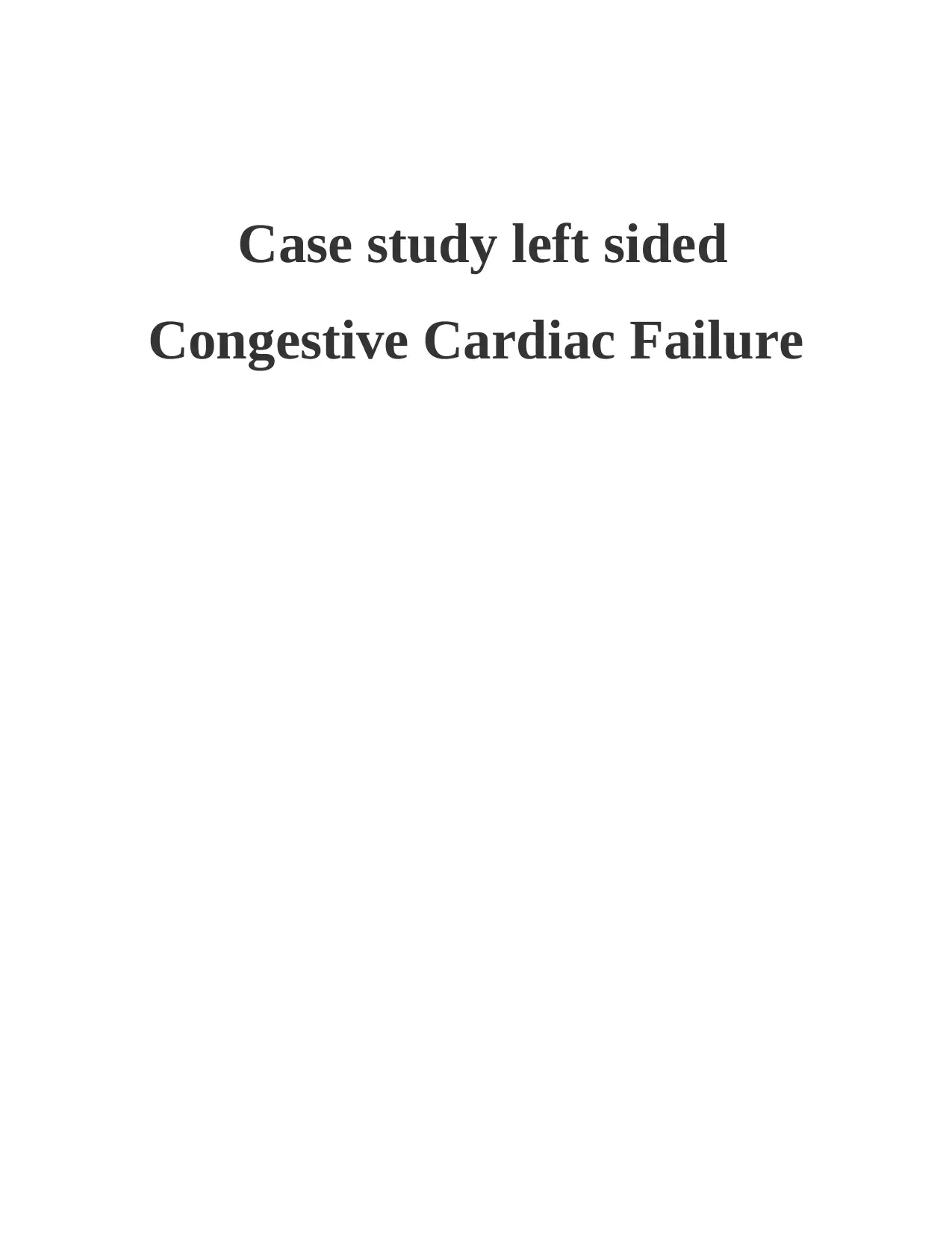
Case study left sided
Congestive Cardiac Failure
Congestive Cardiac Failure
Paraphrase This Document
Need a fresh take? Get an instant paraphrase of this document with our AI Paraphraser
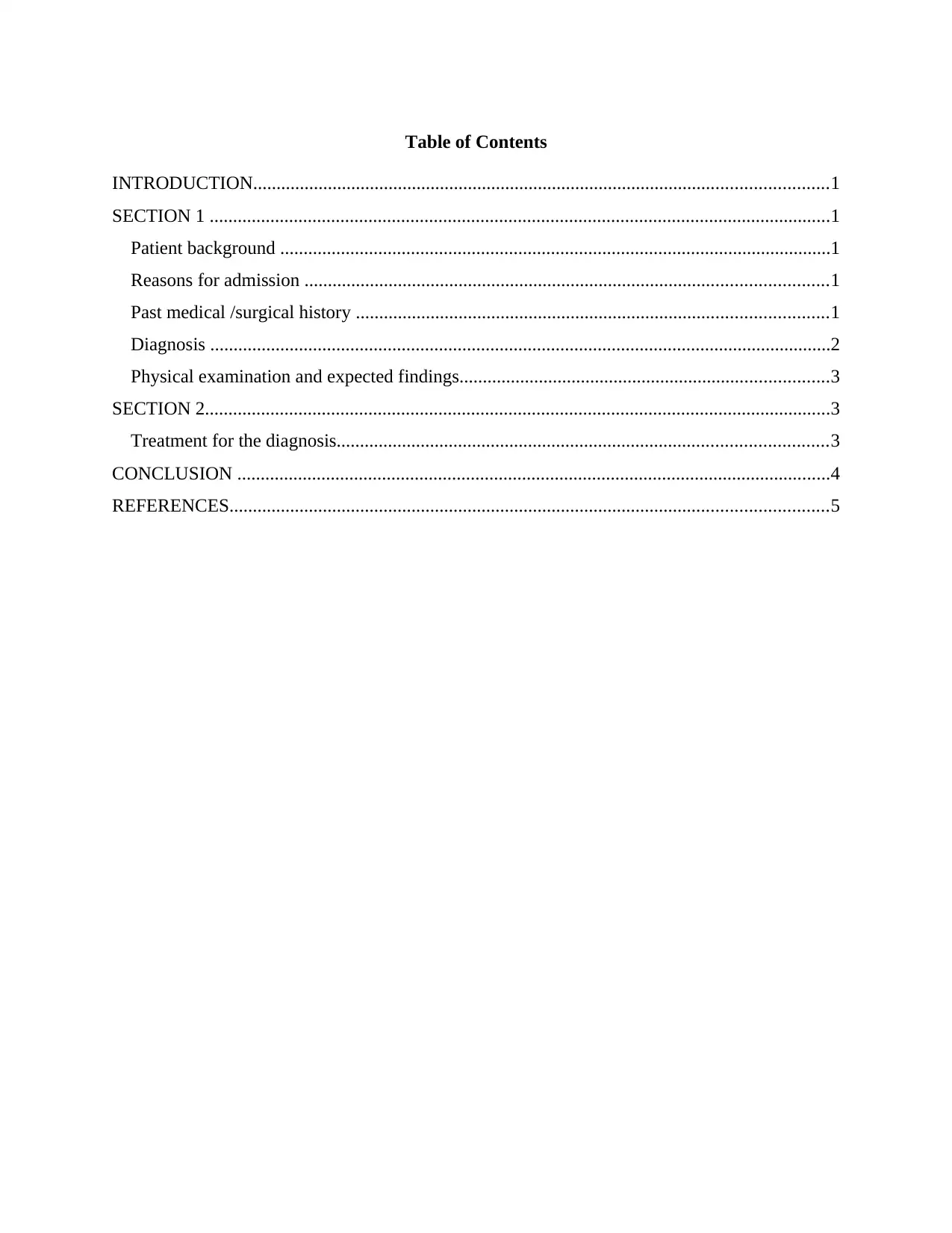
Table of Contents
INTRODUCTION...........................................................................................................................1
SECTION 1 .....................................................................................................................................1
Patient background ......................................................................................................................1
Reasons for admission ................................................................................................................1
Past medical /surgical history .....................................................................................................1
Diagnosis .....................................................................................................................................2
Physical examination and expected findings...............................................................................3
SECTION 2......................................................................................................................................3
Treatment for the diagnosis.........................................................................................................3
CONCLUSION ...............................................................................................................................4
REFERENCES................................................................................................................................5
INTRODUCTION...........................................................................................................................1
SECTION 1 .....................................................................................................................................1
Patient background ......................................................................................................................1
Reasons for admission ................................................................................................................1
Past medical /surgical history .....................................................................................................1
Diagnosis .....................................................................................................................................2
Physical examination and expected findings...............................................................................3
SECTION 2......................................................................................................................................3
Treatment for the diagnosis.........................................................................................................3
CONCLUSION ...............................................................................................................................4
REFERENCES................................................................................................................................5
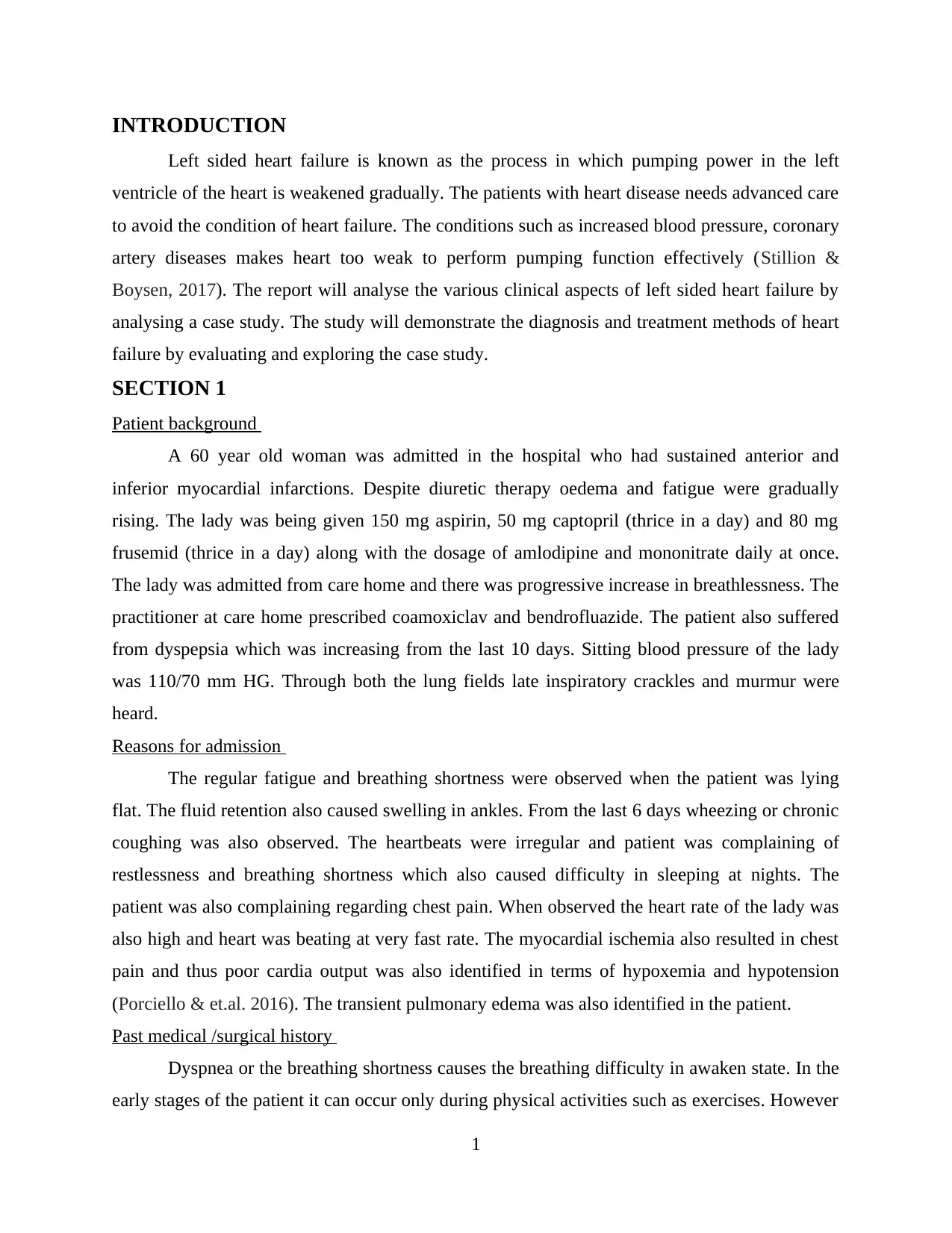
INTRODUCTION
Left sided heart failure is known as the process in which pumping power in the left
ventricle of the heart is weakened gradually. The patients with heart disease needs advanced care
to avoid the condition of heart failure. The conditions such as increased blood pressure, coronary
artery diseases makes heart too weak to perform pumping function effectively (Stillion &
Boysen, 2017). The report will analyse the various clinical aspects of left sided heart failure by
analysing a case study. The study will demonstrate the diagnosis and treatment methods of heart
failure by evaluating and exploring the case study.
SECTION 1
Patient background
A 60 year old woman was admitted in the hospital who had sustained anterior and
inferior myocardial infarctions. Despite diuretic therapy oedema and fatigue were gradually
rising. The lady was being given 150 mg aspirin, 50 mg captopril (thrice in a day) and 80 mg
frusemid (thrice in a day) along with the dosage of amlodipine and mononitrate daily at once.
The lady was admitted from care home and there was progressive increase in breathlessness. The
practitioner at care home prescribed coamoxiclav and bendrofluazide. The patient also suffered
from dyspepsia which was increasing from the last 10 days. Sitting blood pressure of the lady
was 110/70 mm HG. Through both the lung fields late inspiratory crackles and murmur were
heard.
Reasons for admission
The regular fatigue and breathing shortness were observed when the patient was lying
flat. The fluid retention also caused swelling in ankles. From the last 6 days wheezing or chronic
coughing was also observed. The heartbeats were irregular and patient was complaining of
restlessness and breathing shortness which also caused difficulty in sleeping at nights. The
patient was also complaining regarding chest pain. When observed the heart rate of the lady was
also high and heart was beating at very fast rate. The myocardial ischemia also resulted in chest
pain and thus poor cardia output was also identified in terms of hypoxemia and hypotension
(Porciello & et.al. 2016). The transient pulmonary edema was also identified in the patient.
Past medical /surgical history
Dyspnea or the breathing shortness causes the breathing difficulty in awaken state. In the
early stages of the patient it can occur only during physical activities such as exercises. However
1
Left sided heart failure is known as the process in which pumping power in the left
ventricle of the heart is weakened gradually. The patients with heart disease needs advanced care
to avoid the condition of heart failure. The conditions such as increased blood pressure, coronary
artery diseases makes heart too weak to perform pumping function effectively (Stillion &
Boysen, 2017). The report will analyse the various clinical aspects of left sided heart failure by
analysing a case study. The study will demonstrate the diagnosis and treatment methods of heart
failure by evaluating and exploring the case study.
SECTION 1
Patient background
A 60 year old woman was admitted in the hospital who had sustained anterior and
inferior myocardial infarctions. Despite diuretic therapy oedema and fatigue were gradually
rising. The lady was being given 150 mg aspirin, 50 mg captopril (thrice in a day) and 80 mg
frusemid (thrice in a day) along with the dosage of amlodipine and mononitrate daily at once.
The lady was admitted from care home and there was progressive increase in breathlessness. The
practitioner at care home prescribed coamoxiclav and bendrofluazide. The patient also suffered
from dyspepsia which was increasing from the last 10 days. Sitting blood pressure of the lady
was 110/70 mm HG. Through both the lung fields late inspiratory crackles and murmur were
heard.
Reasons for admission
The regular fatigue and breathing shortness were observed when the patient was lying
flat. The fluid retention also caused swelling in ankles. From the last 6 days wheezing or chronic
coughing was also observed. The heartbeats were irregular and patient was complaining of
restlessness and breathing shortness which also caused difficulty in sleeping at nights. The
patient was also complaining regarding chest pain. When observed the heart rate of the lady was
also high and heart was beating at very fast rate. The myocardial ischemia also resulted in chest
pain and thus poor cardia output was also identified in terms of hypoxemia and hypotension
(Porciello & et.al. 2016). The transient pulmonary edema was also identified in the patient.
Past medical /surgical history
Dyspnea or the breathing shortness causes the breathing difficulty in awaken state. In the
early stages of the patient it can occur only during physical activities such as exercises. However
1
⊘ This is a preview!⊘
Do you want full access?
Subscribe today to unlock all pages.

Trusted by 1+ million students worldwide
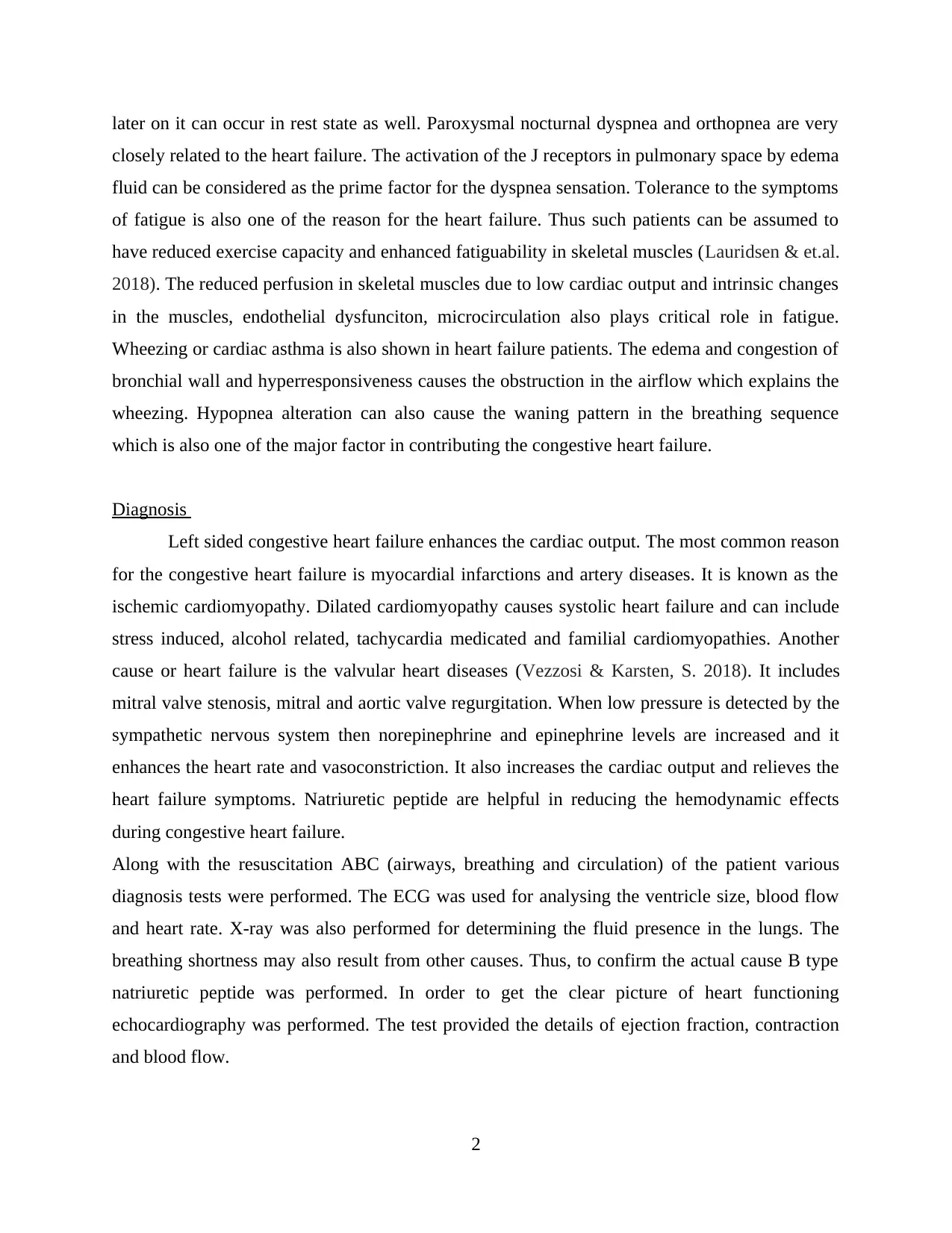
later on it can occur in rest state as well. Paroxysmal nocturnal dyspnea and orthopnea are very
closely related to the heart failure. The activation of the J receptors in pulmonary space by edema
fluid can be considered as the prime factor for the dyspnea sensation. Tolerance to the symptoms
of fatigue is also one of the reason for the heart failure. Thus such patients can be assumed to
have reduced exercise capacity and enhanced fatiguability in skeletal muscles (Lauridsen & et.al.
2018). The reduced perfusion in skeletal muscles due to low cardiac output and intrinsic changes
in the muscles, endothelial dysfunciton, microcirculation also plays critical role in fatigue.
Wheezing or cardiac asthma is also shown in heart failure patients. The edema and congestion of
bronchial wall and hyperresponsiveness causes the obstruction in the airflow which explains the
wheezing. Hypopnea alteration can also cause the waning pattern in the breathing sequence
which is also one of the major factor in contributing the congestive heart failure.
Diagnosis
Left sided congestive heart failure enhances the cardiac output. The most common reason
for the congestive heart failure is myocardial infarctions and artery diseases. It is known as the
ischemic cardiomyopathy. Dilated cardiomyopathy causes systolic heart failure and can include
stress induced, alcohol related, tachycardia medicated and familial cardiomyopathies. Another
cause or heart failure is the valvular heart diseases (Vezzosi & Karsten, S. 2018). It includes
mitral valve stenosis, mitral and aortic valve regurgitation. When low pressure is detected by the
sympathetic nervous system then norepinephrine and epinephrine levels are increased and it
enhances the heart rate and vasoconstriction. It also increases the cardiac output and relieves the
heart failure symptoms. Natriuretic peptide are helpful in reducing the hemodynamic effects
during congestive heart failure.
Along with the resuscitation ABC (airways, breathing and circulation) of the patient various
diagnosis tests were performed. The ECG was used for analysing the ventricle size, blood flow
and heart rate. X-ray was also performed for determining the fluid presence in the lungs. The
breathing shortness may also result from other causes. Thus, to confirm the actual cause B type
natriuretic peptide was performed. In order to get the clear picture of heart functioning
echocardiography was performed. The test provided the details of ejection fraction, contraction
and blood flow.
2
closely related to the heart failure. The activation of the J receptors in pulmonary space by edema
fluid can be considered as the prime factor for the dyspnea sensation. Tolerance to the symptoms
of fatigue is also one of the reason for the heart failure. Thus such patients can be assumed to
have reduced exercise capacity and enhanced fatiguability in skeletal muscles (Lauridsen & et.al.
2018). The reduced perfusion in skeletal muscles due to low cardiac output and intrinsic changes
in the muscles, endothelial dysfunciton, microcirculation also plays critical role in fatigue.
Wheezing or cardiac asthma is also shown in heart failure patients. The edema and congestion of
bronchial wall and hyperresponsiveness causes the obstruction in the airflow which explains the
wheezing. Hypopnea alteration can also cause the waning pattern in the breathing sequence
which is also one of the major factor in contributing the congestive heart failure.
Diagnosis
Left sided congestive heart failure enhances the cardiac output. The most common reason
for the congestive heart failure is myocardial infarctions and artery diseases. It is known as the
ischemic cardiomyopathy. Dilated cardiomyopathy causes systolic heart failure and can include
stress induced, alcohol related, tachycardia medicated and familial cardiomyopathies. Another
cause or heart failure is the valvular heart diseases (Vezzosi & Karsten, S. 2018). It includes
mitral valve stenosis, mitral and aortic valve regurgitation. When low pressure is detected by the
sympathetic nervous system then norepinephrine and epinephrine levels are increased and it
enhances the heart rate and vasoconstriction. It also increases the cardiac output and relieves the
heart failure symptoms. Natriuretic peptide are helpful in reducing the hemodynamic effects
during congestive heart failure.
Along with the resuscitation ABC (airways, breathing and circulation) of the patient various
diagnosis tests were performed. The ECG was used for analysing the ventricle size, blood flow
and heart rate. X-ray was also performed for determining the fluid presence in the lungs. The
breathing shortness may also result from other causes. Thus, to confirm the actual cause B type
natriuretic peptide was performed. In order to get the clear picture of heart functioning
echocardiography was performed. The test provided the details of ejection fraction, contraction
and blood flow.
2
Paraphrase This Document
Need a fresh take? Get an instant paraphrase of this document with our AI Paraphraser
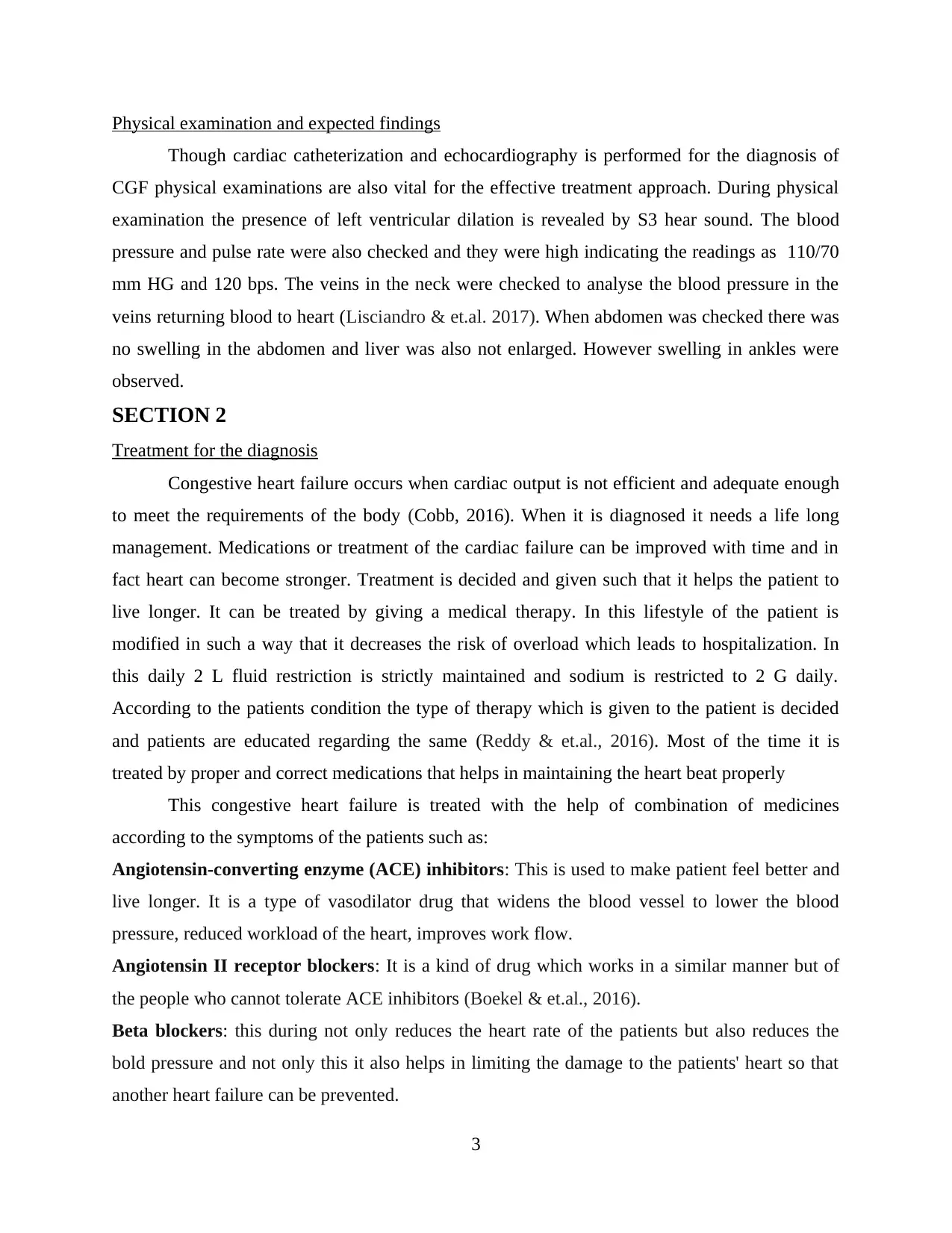
Physical examination and expected findings
Though cardiac catheterization and echocardiography is performed for the diagnosis of
CGF physical examinations are also vital for the effective treatment approach. During physical
examination the presence of left ventricular dilation is revealed by S3 hear sound. The blood
pressure and pulse rate were also checked and they were high indicating the readings as 110/70
mm HG and 120 bps. The veins in the neck were checked to analyse the blood pressure in the
veins returning blood to heart (Lisciandro & et.al. 2017). When abdomen was checked there was
no swelling in the abdomen and liver was also not enlarged. However swelling in ankles were
observed.
SECTION 2
Treatment for the diagnosis
Congestive heart failure occurs when cardiac output is not efficient and adequate enough
to meet the requirements of the body (Cobb, 2016). When it is diagnosed it needs a life long
management. Medications or treatment of the cardiac failure can be improved with time and in
fact heart can become stronger. Treatment is decided and given such that it helps the patient to
live longer. It can be treated by giving a medical therapy. In this lifestyle of the patient is
modified in such a way that it decreases the risk of overload which leads to hospitalization. In
this daily 2 L fluid restriction is strictly maintained and sodium is restricted to 2 G daily.
According to the patients condition the type of therapy which is given to the patient is decided
and patients are educated regarding the same (Reddy & et.al., 2016). Most of the time it is
treated by proper and correct medications that helps in maintaining the heart beat properly
This congestive heart failure is treated with the help of combination of medicines
according to the symptoms of the patients such as:
Angiotensin-converting enzyme (ACE) inhibitors: This is used to make patient feel better and
live longer. It is a type of vasodilator drug that widens the blood vessel to lower the blood
pressure, reduced workload of the heart, improves work flow.
Angiotensin II receptor blockers: It is a kind of drug which works in a similar manner but of
the people who cannot tolerate ACE inhibitors (Boekel & et.al., 2016).
Beta blockers: this during not only reduces the heart rate of the patients but also reduces the
bold pressure and not only this it also helps in limiting the damage to the patients' heart so that
another heart failure can be prevented.
3
Though cardiac catheterization and echocardiography is performed for the diagnosis of
CGF physical examinations are also vital for the effective treatment approach. During physical
examination the presence of left ventricular dilation is revealed by S3 hear sound. The blood
pressure and pulse rate were also checked and they were high indicating the readings as 110/70
mm HG and 120 bps. The veins in the neck were checked to analyse the blood pressure in the
veins returning blood to heart (Lisciandro & et.al. 2017). When abdomen was checked there was
no swelling in the abdomen and liver was also not enlarged. However swelling in ankles were
observed.
SECTION 2
Treatment for the diagnosis
Congestive heart failure occurs when cardiac output is not efficient and adequate enough
to meet the requirements of the body (Cobb, 2016). When it is diagnosed it needs a life long
management. Medications or treatment of the cardiac failure can be improved with time and in
fact heart can become stronger. Treatment is decided and given such that it helps the patient to
live longer. It can be treated by giving a medical therapy. In this lifestyle of the patient is
modified in such a way that it decreases the risk of overload which leads to hospitalization. In
this daily 2 L fluid restriction is strictly maintained and sodium is restricted to 2 G daily.
According to the patients condition the type of therapy which is given to the patient is decided
and patients are educated regarding the same (Reddy & et.al., 2016). Most of the time it is
treated by proper and correct medications that helps in maintaining the heart beat properly
This congestive heart failure is treated with the help of combination of medicines
according to the symptoms of the patients such as:
Angiotensin-converting enzyme (ACE) inhibitors: This is used to make patient feel better and
live longer. It is a type of vasodilator drug that widens the blood vessel to lower the blood
pressure, reduced workload of the heart, improves work flow.
Angiotensin II receptor blockers: It is a kind of drug which works in a similar manner but of
the people who cannot tolerate ACE inhibitors (Boekel & et.al., 2016).
Beta blockers: this during not only reduces the heart rate of the patients but also reduces the
bold pressure and not only this it also helps in limiting the damage to the patients' heart so that
another heart failure can be prevented.
3
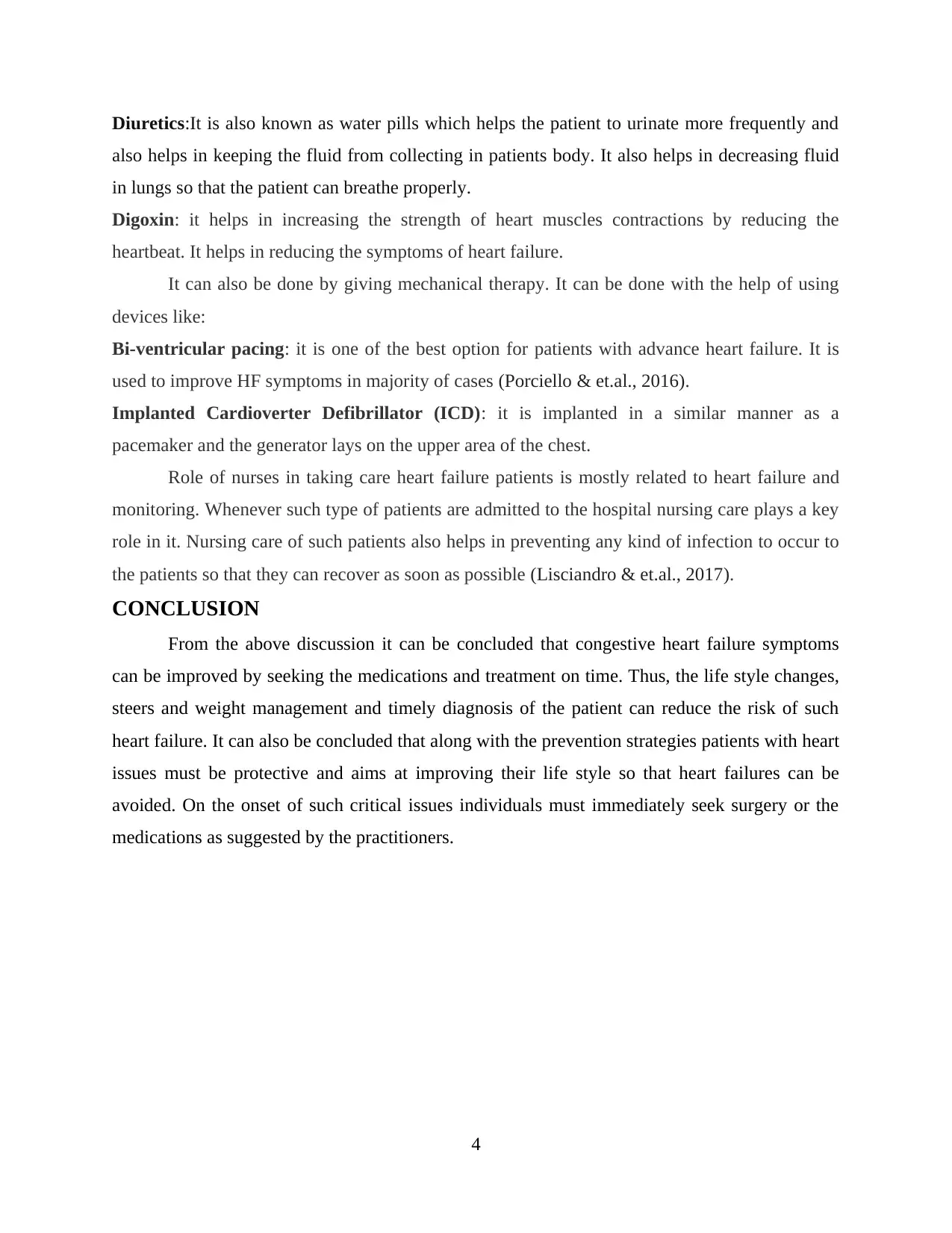
Diuretics:It is also known as water pills which helps the patient to urinate more frequently and
also helps in keeping the fluid from collecting in patients body. It also helps in decreasing fluid
in lungs so that the patient can breathe properly.
Digoxin: it helps in increasing the strength of heart muscles contractions by reducing the
heartbeat. It helps in reducing the symptoms of heart failure.
It can also be done by giving mechanical therapy. It can be done with the help of using
devices like:
Bi-ventricular pacing: it is one of the best option for patients with advance heart failure. It is
used to improve HF symptoms in majority of cases (Porciello & et.al., 2016).
Implanted Cardioverter Defibrillator (ICD): it is implanted in a similar manner as a
pacemaker and the generator lays on the upper area of the chest.
Role of nurses in taking care heart failure patients is mostly related to heart failure and
monitoring. Whenever such type of patients are admitted to the hospital nursing care plays a key
role in it. Nursing care of such patients also helps in preventing any kind of infection to occur to
the patients so that they can recover as soon as possible (Lisciandro & et.al., 2017).
CONCLUSION
From the above discussion it can be concluded that congestive heart failure symptoms
can be improved by seeking the medications and treatment on time. Thus, the life style changes,
steers and weight management and timely diagnosis of the patient can reduce the risk of such
heart failure. It can also be concluded that along with the prevention strategies patients with heart
issues must be protective and aims at improving their life style so that heart failures can be
avoided. On the onset of such critical issues individuals must immediately seek surgery or the
medications as suggested by the practitioners.
4
also helps in keeping the fluid from collecting in patients body. It also helps in decreasing fluid
in lungs so that the patient can breathe properly.
Digoxin: it helps in increasing the strength of heart muscles contractions by reducing the
heartbeat. It helps in reducing the symptoms of heart failure.
It can also be done by giving mechanical therapy. It can be done with the help of using
devices like:
Bi-ventricular pacing: it is one of the best option for patients with advance heart failure. It is
used to improve HF symptoms in majority of cases (Porciello & et.al., 2016).
Implanted Cardioverter Defibrillator (ICD): it is implanted in a similar manner as a
pacemaker and the generator lays on the upper area of the chest.
Role of nurses in taking care heart failure patients is mostly related to heart failure and
monitoring. Whenever such type of patients are admitted to the hospital nursing care plays a key
role in it. Nursing care of such patients also helps in preventing any kind of infection to occur to
the patients so that they can recover as soon as possible (Lisciandro & et.al., 2017).
CONCLUSION
From the above discussion it can be concluded that congestive heart failure symptoms
can be improved by seeking the medications and treatment on time. Thus, the life style changes,
steers and weight management and timely diagnosis of the patient can reduce the risk of such
heart failure. It can also be concluded that along with the prevention strategies patients with heart
issues must be protective and aims at improving their life style so that heart failures can be
avoided. On the onset of such critical issues individuals must immediately seek surgery or the
medications as suggested by the practitioners.
4
⊘ This is a preview!⊘
Do you want full access?
Subscribe today to unlock all pages.

Trusted by 1+ million students worldwide
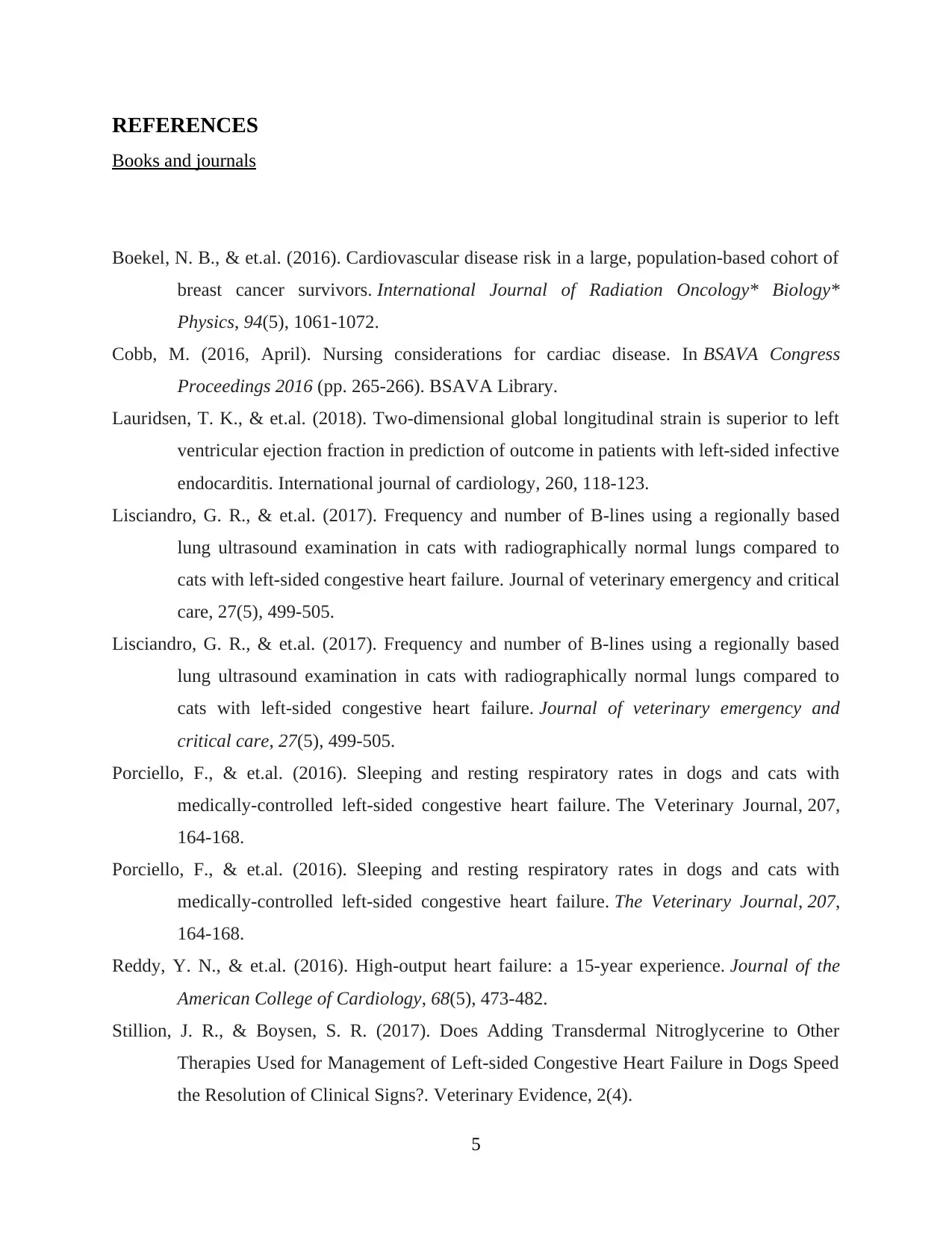
REFERENCES
Books and journals
Boekel, N. B., & et.al. (2016). Cardiovascular disease risk in a large, population-based cohort of
breast cancer survivors. International Journal of Radiation Oncology* Biology*
Physics, 94(5), 1061-1072.
Cobb, M. (2016, April). Nursing considerations for cardiac disease. In BSAVA Congress
Proceedings 2016 (pp. 265-266). BSAVA Library.
Lauridsen, T. K., & et.al. (2018). Two-dimensional global longitudinal strain is superior to left
ventricular ejection fraction in prediction of outcome in patients with left-sided infective
endocarditis. International journal of cardiology, 260, 118-123.
Lisciandro, G. R., & et.al. (2017). Frequency and number of B‐lines using a regionally based
lung ultrasound examination in cats with radiographically normal lungs compared to
cats with left‐sided congestive heart failure. Journal of veterinary emergency and critical
care, 27(5), 499-505.
Lisciandro, G. R., & et.al. (2017). Frequency and number of B‐lines using a regionally based
lung ultrasound examination in cats with radiographically normal lungs compared to
cats with left‐sided congestive heart failure. Journal of veterinary emergency and
critical care, 27(5), 499-505.
Porciello, F., & et.al. (2016). Sleeping and resting respiratory rates in dogs and cats with
medically-controlled left-sided congestive heart failure. The Veterinary Journal, 207,
164-168.
Porciello, F., & et.al. (2016). Sleeping and resting respiratory rates in dogs and cats with
medically-controlled left-sided congestive heart failure. The Veterinary Journal, 207,
164-168.
Reddy, Y. N., & et.al. (2016). High-output heart failure: a 15-year experience. Journal of the
American College of Cardiology, 68(5), 473-482.
Stillion, J. R., & Boysen, S. R. (2017). Does Adding Transdermal Nitroglycerine to Other
Therapies Used for Management of Left-sided Congestive Heart Failure in Dogs Speed
the Resolution of Clinical Signs?. Veterinary Evidence, 2(4).
5
Books and journals
Boekel, N. B., & et.al. (2016). Cardiovascular disease risk in a large, population-based cohort of
breast cancer survivors. International Journal of Radiation Oncology* Biology*
Physics, 94(5), 1061-1072.
Cobb, M. (2016, April). Nursing considerations for cardiac disease. In BSAVA Congress
Proceedings 2016 (pp. 265-266). BSAVA Library.
Lauridsen, T. K., & et.al. (2018). Two-dimensional global longitudinal strain is superior to left
ventricular ejection fraction in prediction of outcome in patients with left-sided infective
endocarditis. International journal of cardiology, 260, 118-123.
Lisciandro, G. R., & et.al. (2017). Frequency and number of B‐lines using a regionally based
lung ultrasound examination in cats with radiographically normal lungs compared to
cats with left‐sided congestive heart failure. Journal of veterinary emergency and critical
care, 27(5), 499-505.
Lisciandro, G. R., & et.al. (2017). Frequency and number of B‐lines using a regionally based
lung ultrasound examination in cats with radiographically normal lungs compared to
cats with left‐sided congestive heart failure. Journal of veterinary emergency and
critical care, 27(5), 499-505.
Porciello, F., & et.al. (2016). Sleeping and resting respiratory rates in dogs and cats with
medically-controlled left-sided congestive heart failure. The Veterinary Journal, 207,
164-168.
Porciello, F., & et.al. (2016). Sleeping and resting respiratory rates in dogs and cats with
medically-controlled left-sided congestive heart failure. The Veterinary Journal, 207,
164-168.
Reddy, Y. N., & et.al. (2016). High-output heart failure: a 15-year experience. Journal of the
American College of Cardiology, 68(5), 473-482.
Stillion, J. R., & Boysen, S. R. (2017). Does Adding Transdermal Nitroglycerine to Other
Therapies Used for Management of Left-sided Congestive Heart Failure in Dogs Speed
the Resolution of Clinical Signs?. Veterinary Evidence, 2(4).
5
Paraphrase This Document
Need a fresh take? Get an instant paraphrase of this document with our AI Paraphraser
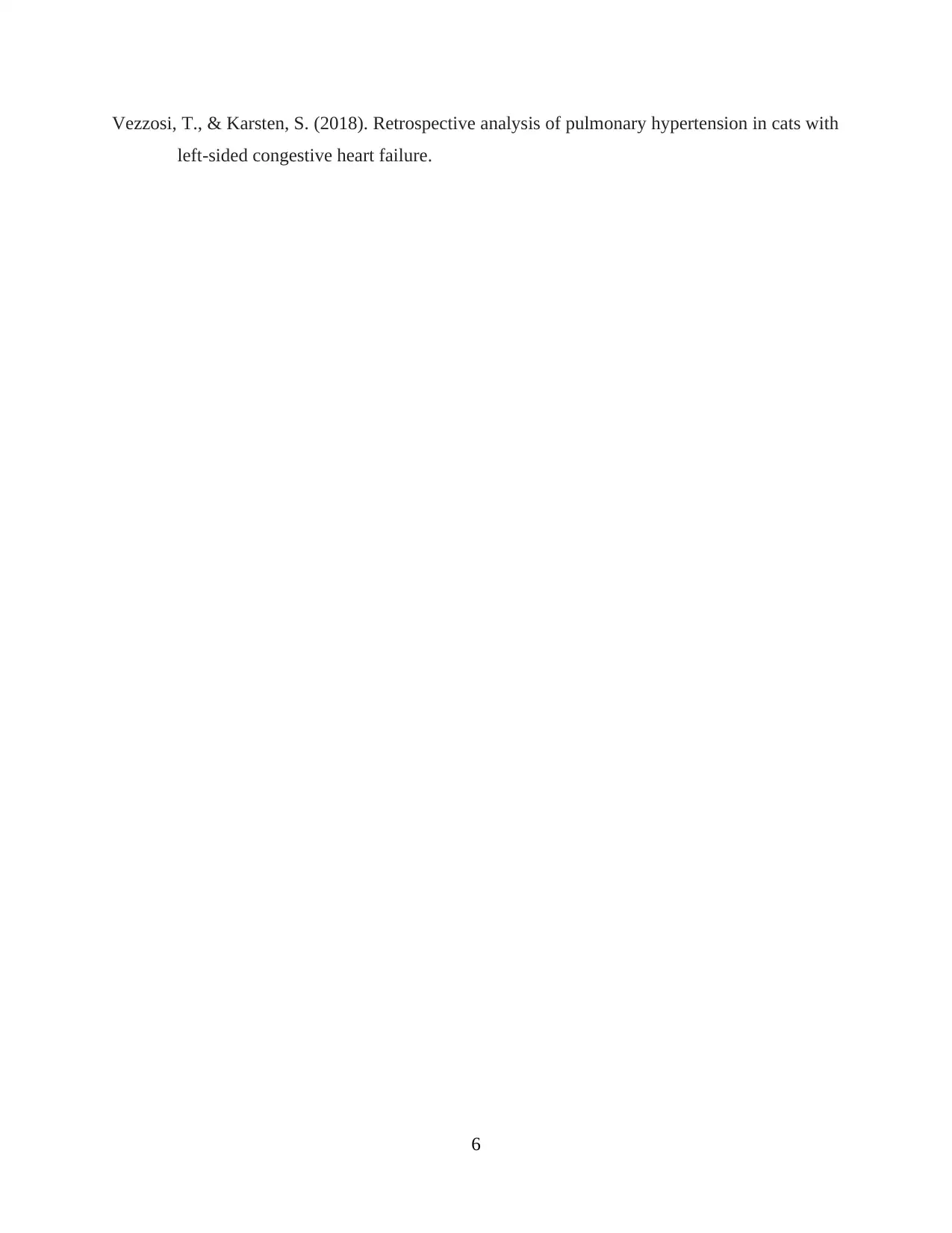
Vezzosi, T., & Karsten, S. (2018). Retrospective analysis of pulmonary hypertension in cats with
left-sided congestive heart failure.
6
left-sided congestive heart failure.
6

7
⊘ This is a preview!⊘
Do you want full access?
Subscribe today to unlock all pages.

Trusted by 1+ million students worldwide

8
Paraphrase This Document
Need a fresh take? Get an instant paraphrase of this document with our AI Paraphraser

9

10
⊘ This is a preview!⊘
Do you want full access?
Subscribe today to unlock all pages.

Trusted by 1+ million students worldwide
1 out of 12
Related Documents
Your All-in-One AI-Powered Toolkit for Academic Success.
+13062052269
info@desklib.com
Available 24*7 on WhatsApp / Email
![[object Object]](/_next/static/media/star-bottom.7253800d.svg)
Unlock your academic potential
Copyright © 2020–2025 A2Z Services. All Rights Reserved. Developed and managed by ZUCOL.





